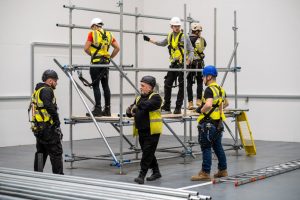
In the busy world of construction, safety standards are not merely an option but a priority. Staying ahead of the latest construction safety standards is paramount to ensure a safe working environment.
Today’s safety standards have moved beyond a simple checklist approach, focusing instead on establishing a consistently safe and positive workspace.
This proactive shift illustrates a significant stride towards enhancing worker safety, thereby diminishing work-related mishaps and encouraging a healthier, happier workforce.
A recent Health and Safety Executive (HSE) report revealed that two million workers in Great Britain suffered from work-related ill health in 2022/23, which is taking a toll on the nation’s productivity. An estimated 35.2 million working days were lost in 2022/23 due to self-reported work-related ill health or injury, of which just under 3% (Access Industry Forum, 2023) took place in the scaffolding arena.
The HSE report also delves into the economic impact of work-related ill health and workplace injuries and HSE’s Chief Executive, Sarah Albon commented, “Preventing or tackling work-related stress can provide significant benefits to employees, improving their experience of work and their overall health; and also to employers including increased productivity, decreased absenteeism, and reduced staff turnover”.
Any new standards established in scaffolding and the wider construction field, emphasise the importance of comprehensive worker training and rigorous competency assessments, ensuring that all members of the workforce are well-equipped to handle their tasks safely and effectively. This not only fosters a safer workspace but also contributes to improved worker performance and overall project outcomes.
Innovation in technology has been a powerful catalyst for the enhancement of safety measures within the construction sector. Technological breakthroughs such as drones, wearable technology and virtual reality simulations have propelled construction safety into a futuristic dimension. Drones, for instance, provide a safer approach for site inspections, reducing the exposure of personnel to hazardous conditions. Meanwhile, wearable technology can track the vital signs of workers, alerting them and their supervisors to potential health risks in real-time. Then, there are virtual reality simulations, an incredibly valuable tool for training.
These simulations can recreate high-risk scenarios without putting workers in actual danger, equipping them with the skills and knowledge to navigate real-life hazards. These remarkable technological advancements do more than just increase safety – they actively facilitate the construction industry’s compliance with the latest safety standards.
To find out more about training available for working at height, please contact CWIC Scaffolding Academy
The HSE report can be found here: https://www.hse.gov.uk/statistics/overview.htm
